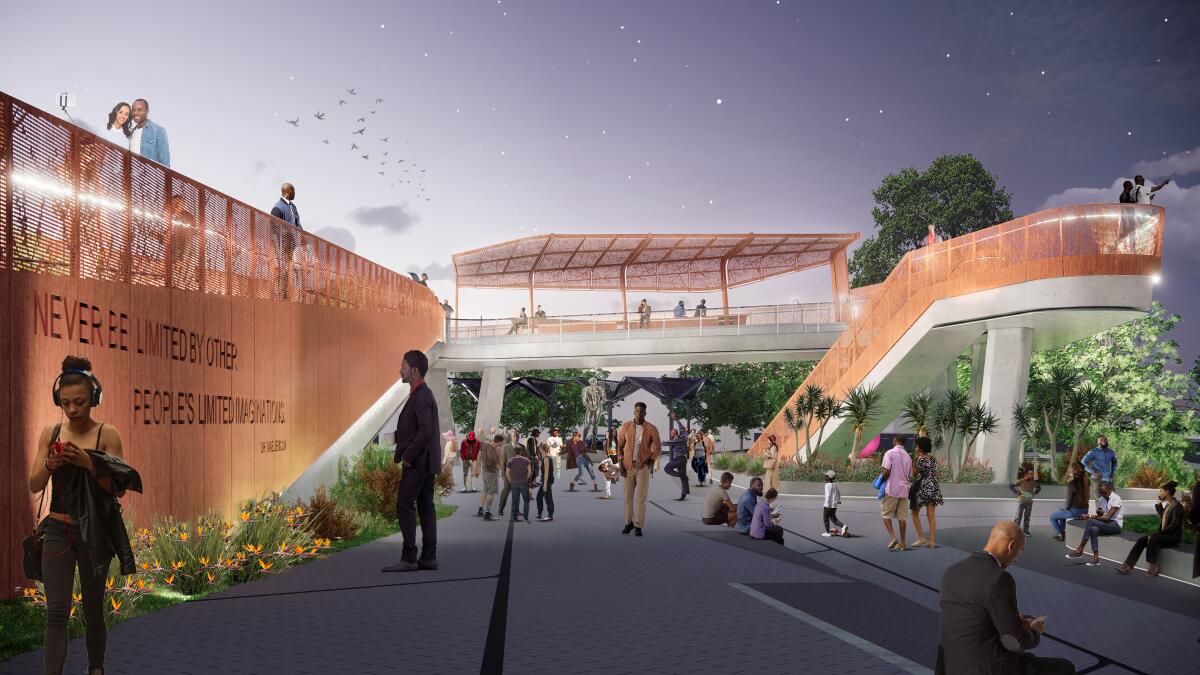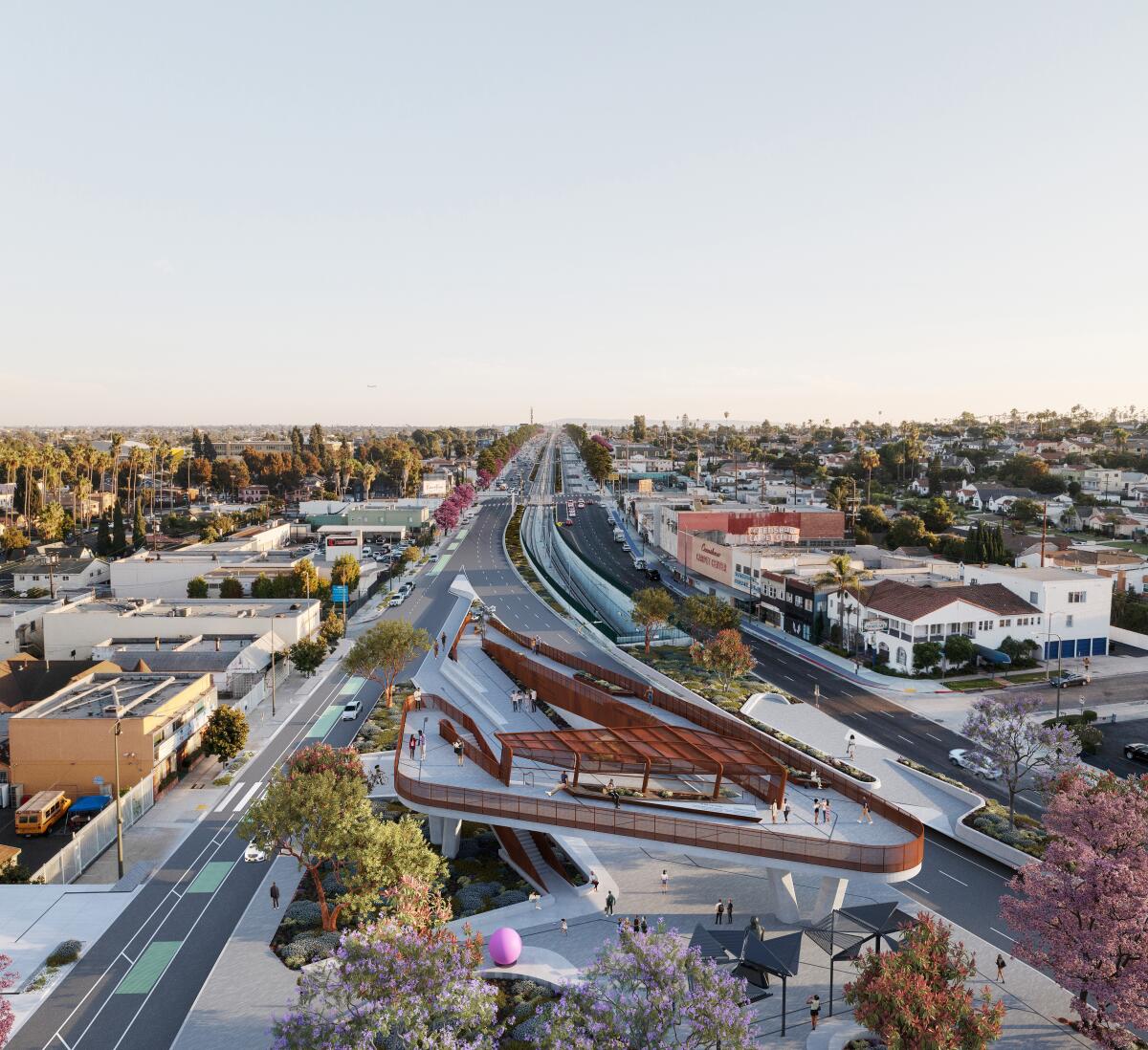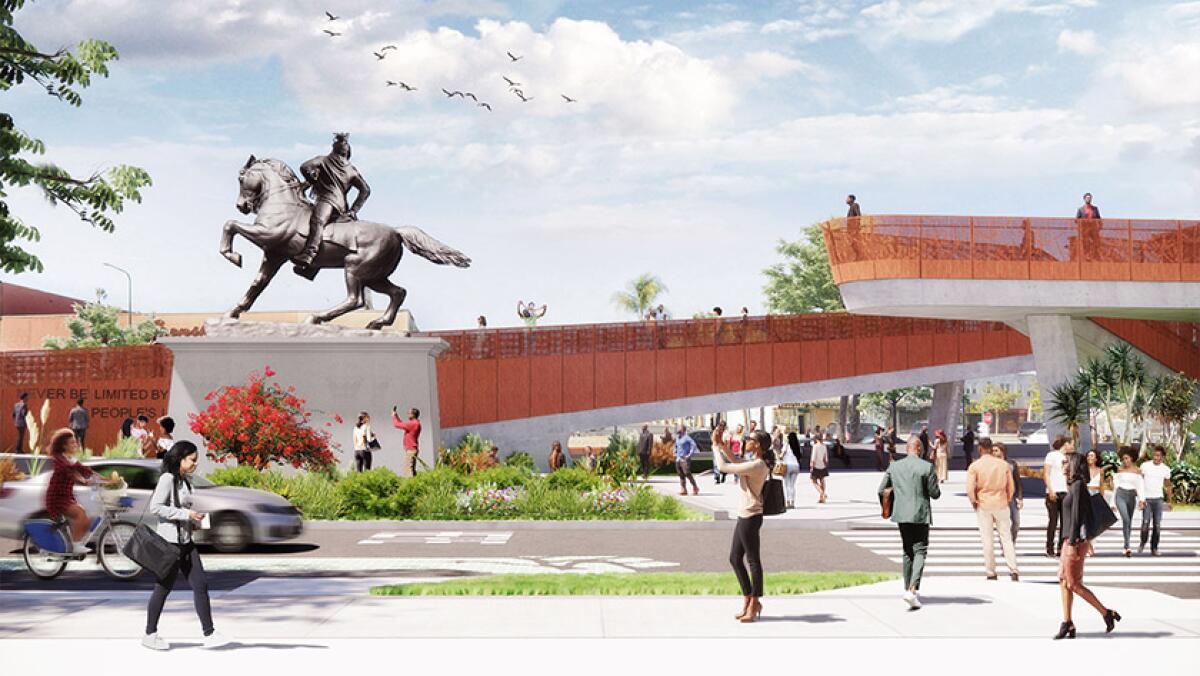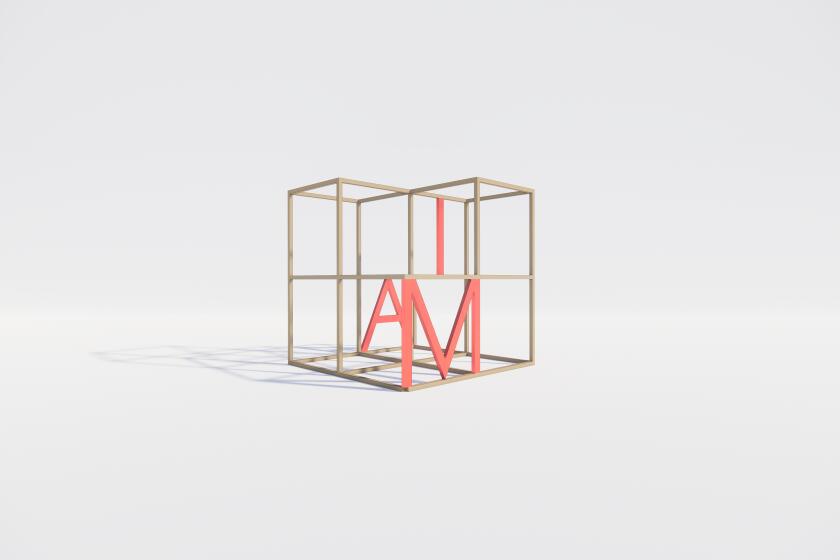Destination Crenshaw to unveil Sankofa Park, the project’s ‘jewel in the crown,’ this fall

- Share via
The first phase of Destination Crenshaw is speeding toward completion, with a boost in both federal funding and nearly completed artworks.
The $100 million, 1.3-mile public art corridor on Crenshaw Boulevard — reflecting and celebrating Black Los Angeles — is scheduled to debut its first public space this fall, the organization announced on Wednesday. The new Sankofa Park, at Crenshaw and Leimert boulevards, will feature permanent, outdoor sculptural installations by artists including Kehinde Wiley, Charles Dickson, Maren Hassinger and Artis Lane.
For the record:
8:38 a.m. Feb. 1, 2023A previous version of this story noted that Sankofa Park will be located at Crenshaw Boulevard and Vernon Avenue. It will be located at Crenshaw and Leimert boulevards.
The project, designed by the architectural design firm Perkins&Will with landscape design by Studio-MLA, adds 4 acres of green space to the area, including nine “pocket parks.” Several of these parks will feature sculptures by Alison Saar, Melvin Edwards and Brenna Youngblood. Five of the pocket parks will debut in December; the other four will open in 2024.
“It’s incredibly exciting,” says Destination Crenshaw President and COO Jason W. Foster, adding that Sankofa Park — the “jewel in the crown” of the project — successfully pushed through pandemic challenges. “To come out of that, with the progress we’ve made, and to be finishing Sankofa Park this year,” he says, “allows us to say not only did our aspirations come to life, but we have something here that will be here moving forward.”
On a crisp late fall day, hundreds of South L.A. community leaders, activists and longtime residents convened on the top level of a parking structure adjoining the Baldwin Hills Crenshaw Plaza shopping center.
Funding for Destination Crenshaw, a public-private initiative, now stands at $72 million.
The project’s private fundraising arm, the Sankofa Circle support group — headed by “Insecure” actress Issa Rae and Chicago Bulls player DeMar DeRozan — has raised $2.4 million. Destination Crenshaw also has been awarded $3.4 million in federal Community Project Funding, which in 2021 gave the project an additional $1 million. The Getty Foundation provided $3 million for the acquisition, fabrication and installation of the project’s first seven artworks as well as conservation planning for them. The Los Angeles County Metropolitan Transportation Authority contributed $14.5 million. There has been additional public and private support since the project’s launch in 2017.
The ambitious public art project, which will run along the new K Line, formerly called the Crenshaw/LAX Line, will transform the area in many ways, organizers say.

Mayor Karen Bass noted, in the announcement, the “much needed cultural tourism and economic development” it will bring. She said she was proud that “Los Angeles was reinvesting in communities that had suffered historical neglect and disinvestment.”
Since its inception, Destination Crenshaw has made a point of supporting Black-owned businesses and hiring local workers, Foster says. General contractor PCL Construction has been working with the community organization 2nd Call to recruit workers from South L.A.
“We wanted to use Destination Crenshaw’s construction as an opportunity to grow the career pipeline,” says Foster, “so we developed a workforce development program focused on recruiting, hiring and training new construction workers from the community.”
Aesthetically, he adds, the neighborhood will feature imagery inspired by the Sankofa bird — a traditional African symbol and an animal that can turn its neck 180 degrees, looking both backwards and forwards — as well as resilient African giant star grass, which was used as bedding on slave ships. “The story of that migration is actually the story of all Black Angelenos,” Foster says. “We’ve all migrated from somewhere but now we live here and we want to grow our roots.”

Destination Crenshaw will include more than 50 mural projects, all by local artists. Works by Anthony “Toons One” Martin, Patrick Henry Johnson and Kisasi Ramsess are in development and will begin installation this spring, with an eye toward debuting alongside Sankofa Park. Other mural projects will be announced later this year.
One mural project is the reimagining of the historic Crenshaw Wall depicting influential African Americans, “Our Mighty Contribution,” which has been an integral landmark in the community. Destination Crenshaw will work with the collective RTN Crew, which has been active in the community for more than two decades and which painted the latest iteration of the mural.
The Los Angeles Cultural Affairs Commission approved Destination Crenshaw’s seven inaugural public art projects on Oct. 13. Here’s what to expect.
In all, Destination Crenshaw will commission more than 100 artists, through 2027, to create works along the boulevard — what Foster calls the “largest commissioning project ever undertaken for Black artists.”
“Like the Sankofa bird, we are flying ahead at full speed toward the inauguration of the first major component of Destination Crenshaw,” L.A. City Councilmember Marqueece Harris-Dawson said in the announcement.
Cultural erasure often happens as a result of big infrastructure projects, Foster notes, but Destination Crenshaw is pointedly — proudly — all about “cultural permanence.”
“We won’t determine whether housing costs go up or down — those are economic forces happening all over L.A. — but we intend to prevent cultural erasure of this important Black neighborhood, one of the largest black neighborhoods on the West Coast,” Foster says. “We want to do that by stamping the neighborhood with unapologetically Black art and an infrastructure project that will persuade Black people to stay in their homes, and not leave, or to move here. To create a cultural space that recognizes the value that we hold as Black people.”
More to Read
The biggest entertainment stories
Get our big stories about Hollywood, film, television, music, arts, culture and more right in your inbox as soon as they publish.
You may occasionally receive promotional content from the Los Angeles Times.












